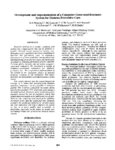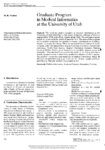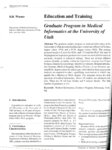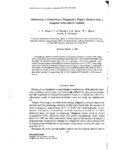|
|
Creator | Title | Description | Subject | Date |
| 1 |
 |
Gesteland, Raymond F.; Ives, Jeffrey T.; Stockham, Thomas G. | Automated film reader for DNA sequencing based on homomorphic deconvolution | An automated reader for electrophoresis based DNA sequencing methods is described that provides fast and accurate sequence determination. Digitized sequencing lanes are processed with homomorphic blind deconvolution in preparation for peak detection, interlane alignment, peak refinement and base cal... | Sequence Analysis; Electrophoresis; Automated Film Reader; Homomorphic Deconvolution | 1994 |
| 2 |
 |
Warner, Homer R. | Automated Transformation of Probabilistic Knowledge for a Medical Diagnostic System | Biomedical Informatics | | 1994 |
| 3 |
 |
Warner, Homer R. | Automated Transformation of Probablistic Knowledge for a Medical Diagnostic System | Biomedical Informatics | | 1994 |
| 4 |
 |
Couldwell, William T. | Comment on: Chronic brain inflammation and persistent herpes simplex virus 1 thymidine kinase expression in survivors of syngeneic glioma treated by adenovirus-mediated gene therapy: implications for clinical trials | The long-term consequences of adenovirus-mediated conditional cytotoxic gene therapy for gliomas remain uncharacterized. We report here detection of active brain inflammation 3 months after successful inhibition of syngeneic glioma growth. The inflammatory infiltrate consisted of activated macrophag... | Brain inflammation; Herpes simplex virus-1; Thymidine kinase; Syngeneic glioma; Adenovirus-mediated gene therapy | 1994 |
| 5 |
 |
Kriesel, John D.; Baringer, J R; Spruance, Spotswood L. | Correlation between detection of herpes simplex virus in oral secretions by PCR and susceptibility to experimental UV radiation-induced herpes labialis. | We examined the oral secretions of 25 patients for herpes simplex virus (HSV) at the time of and following experimental UV radiation (UVR). HSV was detected in one or more oral secretion specimens in 5 of 12 (42%) cases by cell culture and in 8 of 12 (67%) cases by PCR. On the day of UVR, HSV was de... | Polymerase Chain Reaction; Ultraviolet Rays; Simplexvirus | 1994 |
| 6 |
 |
Couldwell, William T. | Cranioplasty with the Medpor porous polyethylene Flexblock implant | The authors describe the use of a porous polyethylene Flexblock implant for cosmetic cranioplasty. The implant may be used to cover any small- or medium-sized (< 8 cm) cranial defect, offering similar cosmetic results to standard alloplast cranioplasty while decreasing operation time. The porous i... | Cranioplasty; Medpor; Alloplast; Polyethylene; Skull defect | 1994 |
| 7 |
 |
Warner, Homer R. | Decision Support in Medicine: Examples from the HELP System | Biomedical Informatics | | 1994 |
| 8 |
 |
Warner, Homer R. | Designing a Controlled Medical Vocabulary Server: The VOSER Project | Biomedical Informatics | | 1994 |
| 9 |
 |
Warner, Homer R. | Development and Implementation of a Computer-Generated Reminder System for Diabetes Preventive Care | Biomedical Informatics | | 1994 |
| 10 |
 |
Kestle, John R. W. | Effect of single-application topical ophthalmic anesthesia in patients with trigeminal neuralgia: a randomized double-blind placebo-controlled trial | To evaluate the reported benefit of ipsilateral single-application ophthalmic anesthetic eyedrops in patients with typical trigeminal neuralgia, a randomized double-blind placebo-controlled trial was performed. Fortyseven patients were randomly assigned to receive two drops of either proparacaine (... | Randomized trial; Ophthalmic anesthesia | 1994 |
| 11 |
 |
Gesteland, Raymond F.; Weiss, Robert B. | Efficient shine- Dalgarno sequence but not translation is necessary for LacZ mRNA stability in Escherichia coli | The 5' ends of many bacterial transcripts are important in determining mRNA stability. A series of Shine-Dalgarno (SD) sequence changes showed that the complementarity of the SD sequence to the anti-SD sequence of 16S rRNA correlates with lacZ mRNA stability in Escherichia coli. Several initiation c... | Protein Biosynthesis; Ribosomes; Escherichia coli; Shine-Dalgarno Sequence | 1994 |
| 12 |
 |
Baehr, Wolfgang | Expression and mutagenesis of mouse rod photoreceptor cGMP phosphodiesterase | Using recombinant baculovirus vectors, the three subunits of mouse rod photoreceptor cGMP phosphodiesterase (PDE) (alpha beta gamma 2) have been expressed in insect cells. The recombinant alpha,beta subunits accumulate to 5 mg/liter culture, but most (98%) of the expressed polypeptides are insoluble... | Electrophoresis, Polyacrylamide Gel; Macromolecular Substances; Protein Processing, Post-Translational | 1994 |
| 13 |
 |
Warner, Homer R. | Graduate Program in Medical Informatics at the University of Utah | Biomedical Informatics | | 1994 |
| 14 |
 |
Warner, Homer R. | Graduate Program in Medical Informatics at the University of Utah | Biomedical Informatics | | 1994 |
| 15 |
 |
Couldwell, William T. | Hypericin: a potential antiglioma therapy | HYPERICIN, A POLYCYCLIC aromatic dione isolated from plants, is presently being clinically evaluated as an antiviral agent in the treatment of human immunodeficiency virus (HIV) infection. In addition, it is known to be a potent protein kinase C inhibitor. To evaluate its potential as an inhibitor o... | Hypericin; Protein kinase C; Glioma; Brain neoplasm | 1994 |
| 16 |
 |
Warner, Homer R. | Interfacing a Stand-Alone Diagnostic Expert System With a Hospital Information System | Biomedical Informatics | | 1994 |
| 17 |
 |
Kriesel, John D.; Gooch, Willis M.; Pavia, Andrew T. | Invasive sinonasal disease due to Scopulariopsis candida: case report and review of scopulariopsosis. | Sinonasal infection with fungi of the order Mucorales--termed mucormycosis or zygomycosis--is sometimes seen in immunosuppressed patients, including those with diabetic ketoacidosis and malignancy. We describe a case of invasive sinonasal infection with Scopulariopsis candida (not among the Mucorale... | Granulocyte Colony-Stimulating Factor; Itraconazole; Maxillary Sinus | 1994 |
| 18 |
 |
Couldwell, William T. | Management of pituitary adenomas | We present an overview of the management of pituitary adenomas, with discussions of microanatomy, of diagnostic studies of general neuroendocrine function, and of radiologic evaluation. We discuss the diagnosis of pituitary adenoma and its treatment with sections on null cell, prolactin (PRL)-secre... | Pituitary adenoma; Transsphenoidal surgery; Corticotropin; Prolactin; Growth hormone; Transcranial surgery | 1994 |
| 19 |
 |
Baehr, Wolfgang | Molecular characterization of human and mouse photoreceptor guanylate cyclase-activating protein (GCAP) and chromosomal localization of the human gene | Guanylate cyclase-activating protein (GCAP) is a novel Ca(2+)-binding protein that stimulates synthesis of cGMP in photoreceptors. Molecular cloning of human and mouse GCAP cDNA revealed that the known mammalian GCAPs are more than 90% similar, consist of 201-205 amino acids, and contain three ident... | Amino Acid Sequence; Base Sequence; Cloning, Molecular | 1994 |
| 20 |
 |
Couldwell, William T. | Multifocal inflammatory leukoencephalopathy associated with levamisole and 5-fluorouracil: case report | LEVAMISOLE AND 5-FLUOROURACIL have now become the standard chemotherapeutic regimen for patients with Stage 111 colon carcinoma. A case of multifocal inflammatory leukoencephalopathy secondary to levamisole alone or combination of levamisole and 5-fluorouracil is reported. Magnetic resonance imaging... | Autopsy; Levamisole; Multifocal inflammatory leukoencephalopathy | 1994 |
| 21 |
 |
Schmidt, Meic H. | Photodynamic therapy | We appreciate the comments of Drs. Kaye and Hill on our article. We are pleased that these investigators concurred with our impression that photodynamic therapy (PDT) may potentially be useful in the treatment of posterior fossa tumors. Several interesting questions were raised about the technical ... | Photodynamic therapy; Photofrin | 1994 |
| 22 |
 |
Couldwell, William T. | Protein kinase C and growth regulation in malignant gliomas | To the Editor: The presence of amplified growth factor systems in many tumor models, including malignant gliomas, raises the question of how such external signals are transduced into a transformed phenotype (increased proliferation, invasion, lack of contact inhibition, angiogenic capacity, etc.). ... | Protein kinase C; Glioma; Brain neoplasm; protooncogenes; Apoptosis; Tamoxifen | 1994 |
| 23 |
 |
Gesteland, Raymond F.; Atkins, John F.; Wills, Norma M. | rRNA-mRNA base pairing stimulates a programmed -1 ribosomal frameshift | Base pairing between the 3' end of 16S rRNA and mRNA is shown to be important for the programmed -1 frameshifting utilized in decoding the Escherichia coli dnaX gene. This pairing is the same as the Shine-Dalgarno pairing used by prokaryotic ribosomes in selection of translation initiators, but for ... | Frameshifting; Escherichia coli; Binding Sites; Base Composition | 1994 |
| 24 |
 |
Couldwell, William T. | Surgical approaches to petroclival meningiomas part I: upper and midclival approaches | Strictly considered, petroclival meningiomas represent only a percentage of the 10% of all intracranial meningiomas that reside in the posterior fossa. Although not statistically frequent, with their location in proximity to cranial nerves, the basilar artery and its perforating branches, and t... | Petroclival meningiomas; Petroclivus; Surgical approach; Upper clivus; Midclivus | 1994 |
| 25 |
 |
Couldwell, William T. | Surgical approaches to petroclival meningiomas Part II: extended approaches | In Part I, the classification, clinical presentation, and upper and midclival surgical approaches were discussed. This lesson covers extended surgical approaches, results, complications, and adjuvant therapy. | Petroclival meningiomas; Petroclivus; Surgical approach; Staged surgery; Complications; Adjuvant therapy; Radiosurgery; Resections | 1994 |

























